As the war in Afghanistan enters its 10th year, the operational pace and harsh physical conditions are taking a toll on USAF aircraft. These flying systems go through a wringer of intense heat, salty air, and raging sandstorms at bases throughout Southwest Asia. It often falls to deployed USAF maintainers, on duty 24 hours a day, seven days a week, to keep them running at all.
The weather “is probably the biggest challenge we face in terms of taking care of the people and the aircraft,” said Lt. Col. Jennifer Hammerstedt, commander of the 379th Expeditionary Aircraft Maintenance Squadron.
On a “moderate” summer day at a Middle East base, she observed, temperatures can soar above 120 degrees Fahrenheit. As the sun beats down and with the blacktop absorbing the heat, the flight line can typically climb 10 degrees above that.
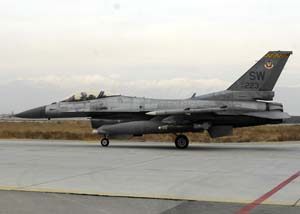 |
|
“That means that, with the heat, everything you touch out on the flight line can be 130 degrees or more,” Hammerstedt said. “So it’s usually much hotter out where the guys are working.”
Humidity exceeds 80 percent on some days and, said Hammerstedt, “you can definitely feel it.” The wind can offer some relief, she said, but with the wind comes the sand, which can enter aircraft through the smallest of openings.
Hammerstedt is in charge of maintenance for a wide variety of aircraft at war in Southwest Asia. That makes her responsible for the operability of “very diverse, very different airframes.”
Air Force leadership acknowledges the challenges of conditions and optempo. “These operations continue to stress both people and platforms,” Gen. Carrol H. Chandler, vice chief of staff for the Air Force, told the Senate Armed Services Subcommittee on Readiness and Management Support. “Operations tempo continues to take a toll, and many of our aircraft are increasingly unavailable due to required maintenance.”
On the flight lines, maintainers regularly reposition the aircraft so the wind doesn’t blow sand up the intakes of the jet engines. “We reposition the planes 90 degrees, so the wind is blowing across the side,” explained CMSgt. Terry Neuharth, superintendent of a B-1 bomber aircraft unit. “As much sand is in the air, it obviously goes through the engine, and it reduces performance,” he said. “We monitor the engine, to make sure the performance doesn’t deteriorate.”
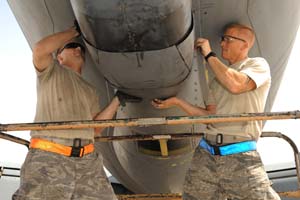 |
|
Even as the jet aircraft are taxiing down the runway, they are at risk from the heat. “A lot of times, we have to be careful” about its potential effects, cautioned Neuharth. Air Force maintainers on the runway fire handheld laser thermometers, which resemble highway patrol radar guns, toward the tires of the jet aircraft. “If it’s below 140 degrees, we let it take off,” Neuharth explained. “If not, we make them sit for 20 minutes.” This is because as the tire rubber gets hotter, “it’s a lot softer,” he added. At soaring temperatures, there is a risk that the tires might “blow up on takeoff.” On a hot day, the tarmac temperature can reach 160 degrees, Neuharth noted.
Bagram Airfield, Afghanistan, has its own range of challenges. The sandstorms—known as “brownouts”—roll in quickly and can muck up engine systems. This particularly affects the HH-60 helicopters used by the combat search and rescue personnel, said Maj. James Upchurch of the 455th Expeditionary Aircraft Maintenance Squadron.
“The environment really does affect them,” he said, especially in a region “where dust and dirt get in the engines.” Sand also seems to gravitate toward even the smallest drop of oil, airmen noted.
To keep the aircraft safely running, “we have to do additional maintenance to clean them up,” Upchurch said. This includes jet washing the engine, which entails pressure washing to get rid of all the sand and dirt. “When the rotors stir up the dust, it degrades engine performance.”
Maintainers take care to make sure canopies are closed and the protective covers are put on the inlet and the exhaust of the engines. These covers shield equipment such as angle of attack probes, which sense whether an airplane is in a climb or banking to the right or the left.
Sand, Wind, Dirt, Rocks
The wind offers its own challenges. “We just recently saw over [52 mph] in the afternoon,” Upchurch said. “It’s kind of a constant,” he added, estimating that it tends to blow at “anywhere between [29 to 52 mph],” so “we have to make sure everything is tied down.” He said, “We tie down the airplanes after every flight.”
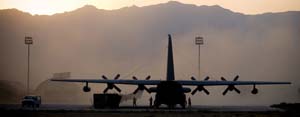 |
Crews ready an EC-130H Compass Call at Bagram Airfield. (USAF photo by SSgt. Samuel Morse) |
C-130 cargo airplanes are landing “on unimproved surfaces every day,” Upchurch explained. This includes temporary runways and dirt landing strips out at the far-flung forward operating bases that dot the mountains of eastern Afghanistan and the high desert of the south. “When you land on unimproved surfaces, you’re kicking up rocks, dirt, things of that nature,” Upchurch said. “It also puts a stress on the brakes and the tires.” That creates additional maintenance requirements for the airmen.
They also see wear and tear in the airplanes’ panels, when rocks get kicked up and dent them. “We have to determine whether it’s in the limits or not,” Upchurch said. “We either fabricate or put a panel on the stretcher itself.” What’s more, he added, antennae and probes on the underbelly of the aircraft take a beating.
The heavier loads that the aircraft are hauling can also increase the effect of the elements, airmen add. This is especially true in the case of fighters such as F-15s and F-16s.
“The weight that they’re carrying puts a little bit more of a strain on the brakes and the tires,” Upchurch said. “We’re going through those a lot more, and changing them out a lot more. … We’re flying more hours than if we were in our home station.” He estimates that four months of flying in Afghanistan “equals a year of flying at home station.” The operational tempo, combined with the elements, means that “things are going to start breaking down a lot faster.”
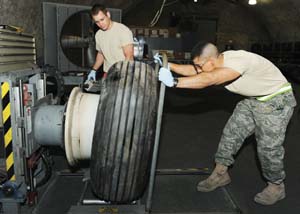 |
|
Coming from her home station of Elmendorf AFB, Alaska, Hammerstedt has noticed that “these airplanes can be quirky or temperamental when they are accustomed to flying in one temperature, and then they come to a different climate.”
She added, “You can have problems with hydraulic components like landing gear,” and “radar and cooling systems can be overworked.” Because of the wide spectrum of airframes operating in theater, some of them have problems with hydraulics or engines overheating, others with radar and communications systems that have “more sensitive platforms,” Hammerstedt said.
She went on to say, “Some of the systems that have a lot of radar, they have components that will heat up.” When the airplanes are aloft, they are all cooled by the aircraft systems. “But when you run them off the ground, you have to use other pieces of equipment, like air-conditioning type of units,” she said. “It’s like when your computer gets hot when it operates, but it’s on a different level.”
Sheer distances cause problems, too. While normal sorties back at home station are one-and-a-half to two-and-a-half-hours, “sorties here are around 12 to 14 hours,” said Neuharth. “We definitely fly a lot more hours here than we do at home station—we’re 24 hours a day here.”
Munitions flight supervisors at Bagram say they are concerned about the impact of environmental factors on weapons systems as well. “I can tell you that one of the things we’re seeing is damage to different components of different munitions,” due in part to the intense operational tempo, said SMSgt. David Anthony, the munitions flight supervisor for the 455th EAMXS. “Munitions are designed to be built and expended—not carried on numerous flights.”
A Continuous Process
That means maintainers regularly have to replace components. “By no means do we fly damaged munitions,” Anthony said. But this can also lead to a torrent of work during events such as hailstorms. “We get components back from the sandstorms or the hailstorms that the jets have been through,” he said. “We don’t run into these sorts of situations every day, but it has made a noticeable impact.” Anthony added, “Over the two-and-a-half months that I’ve been here, we’ve had quite a few [munitions] damaged because of weather.”
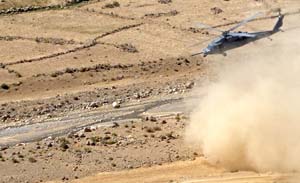 |
|
For example, seeker systems and guidance systems sometimes get broken, and maintainers need to replace components and send the weapons back out. So they take the munitions to the bomb dump to disassemble the components, take off the munitions, replace components, and then retest them.
“It’s a continuous turn process,” Anthony said.
Since most munitions are smart bombs, they are hooked up to a test set. “That tester will tell us whether that munition is good to go,” Anthony noted. “It will tell you what component you need to replace, and which is a dud.”
The maintainers don’t get any time off even in difficult conditions. “Right in the middle of a sandstorm, we still have to launch aircraft out,” Neuharth said. “We don’t stop for the sandstorms or the hot temperatures.” He added, “It’s pretty amazing how these guys work in these conditions. They understand what’s on the line, and that we have to get our jets in the air, because it may save lives.”
Indeed, maintainers must work 12-hour shifts, six days a week, rather than the three shorter shifts they generally work, five days a week, back at their home stations.
“With the shift changes and everything else, it’s closer to 13 or 14 hours, and they’re working that whole time,” Anthony said.
 |
SSgt. Richard Mabry carefully inspects a B-1 wheel bolt for cracks. ( |
Deployed to JB Balad, Iraq, 1st Lt. Michael Adams, the Tiger Aircraft Maintenance Unit officer in charge of F-16s of the 332nd Expeditionary Aircraft Maintenance Squadron, said it is typical to arrange shifts into half daylight hours and half night hours, “so that one group isn’t sleeping in the cool hours, and the other group is trying to sleep in the 120 degree heat.”
While the altitude does not seem to have a great impact on the aircraft that stay under their flight ceilings, it does have an impact on the maintainers.
“You feel it a little bit—nosebleeds, shortness of breath, and when you run, and stuff like that,” Anthony said. “It takes a little bit of acclimation. It probably took me a good month to get my run time back, after going from sea level to about 4,800 feet” in Afghanistan.
Running Hot
At US bases, maintainers see the impact of Afghanistan translating into more unscheduled maintenance, according to Jim Yankel, the technical director for Air Force Materiel Command’s Directorate of Logistics. He has noticed that “higher temperatures typically affect mainly engines, avionic-type systems, electronic boxes—whatever that … electronic box is.”
He added that higher operating temperatures can put thermal distress on the combustors and turbines at a faster rate.
What’s more, sand and dust from Afghanistan “have a tendency to accumulate on some of these components, which will drive additional maintenance as far as water washing, so it doesn’t plug cooling holes and cooling passages within the engine itself,” Yankel added. That’s because “if you plug those cooling passages, you start to run hotter.”
At Tinker AFB, Okla., some 20 KC-135 tankers are being retrofitted with extra piping, as well as probes. “Those are used a lot in Afghanistan,” said Col. Robert Torick, the base’s KC-135 system program manager. As a result, they run 840 hours a year, versus the 580 hours a year that is more customary for the aircraft.
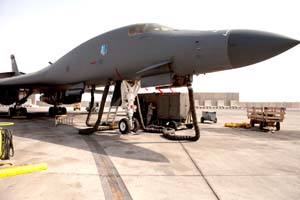 |
|
They also carry a heavy fuel load, which adds to the wear and tear. That, combined with the higher temperatures, can result in fuel leaks. “It’s more of a maintenance burden,” Torick said. Air Force officials add that the impact of conditions on the KC-135 mirrors many of the challenges that face jet engines throughout the theater.
Ralph Garcia, the Propulsion Sustainment Division director, said KC-135 engine removals have been increasing since 2003. Today, they are double what they were just after the Afghan war began. “We’ve gone from in the neighborhood of 45 back in 2002 to 90 annually.” This year, he predicts another increase.
Several of the air bases supporting Afghan operations are located along the coastline of the Persian Gulf. Their geographic location near the salty sea air leads to corrosion problems.
Torick said of the KC-135: “It was built in the early 1950s, and it was not built to resist corrosion. It was built to be really lightweight.” As a result, he said, being forward deployed is “aggravating the issues that we currently face, but we stay on top of them.”
Anna Mulrine, senior editor and defense correspondent for